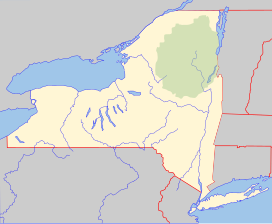| Kane Mountain | |
|---|---|
 View of Canada Lake, West Lake and Lily Lake from fire observation station | |
| Highest point | |
| Elevation | 2,185 feet (666 m) [1] |
| Prominence | 460 ft (140 m) [2] |
| Coordinates | 43°10′51″N74°30′56″W / 43.1809039°N 74.5154199°W [1] |
| Geography | |
| Location | N of Canada Lake, New York, U.S. |
| Topo map | USGS Canada Lake |
Kane Mountain is a mountain in the Adirondack Mountains region of New York. It is located north of the Hamlet of Canada Lake. The Kane Mountain Fire Observation Station is located on top of the mountain. Sheeley Mountain is located south-southwest, Canada Lake is located south, Camelhump is located east and Pine Lake is located north of Kane Mountain. [2] [3] [4]


